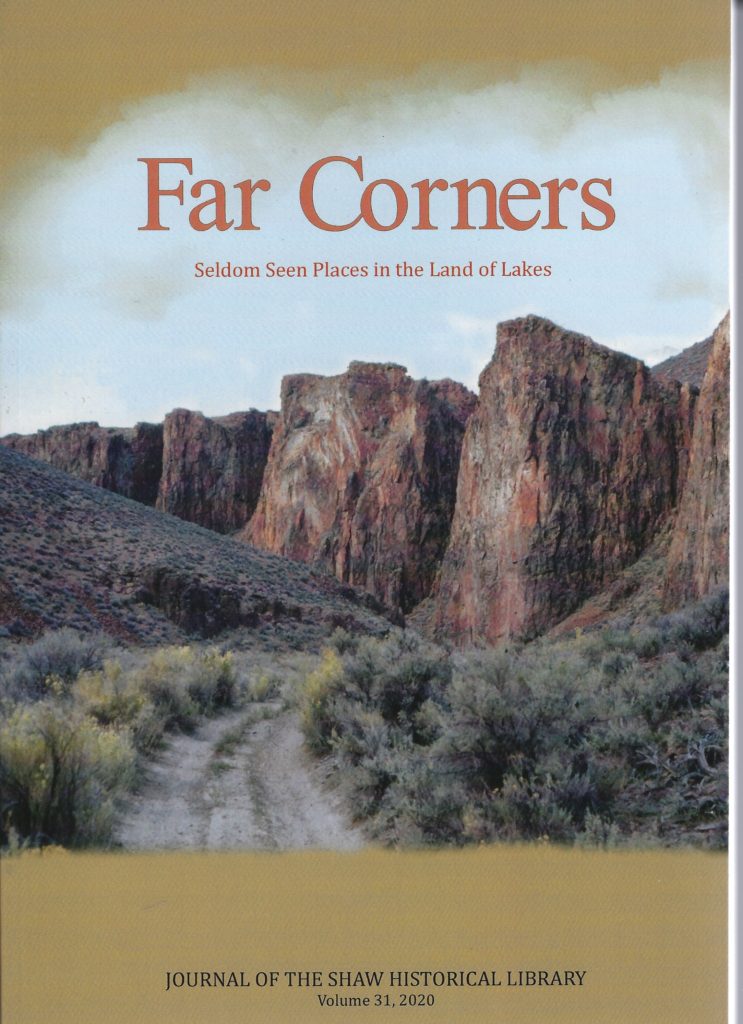
Seldom seen places, from forgotten settlements in
northern Klamath and Lake counties to “Ghosts” of Crater Lake National Park and the Tri-Corners area where the states of Oregon, California and Nevada come together are featured in the newly released 2020 Journal of the Shaw Historical Library.
“Far Corners: Seldom Seen Places in the Land of the Lakes,”
features stories by a variety of authors about settlements and
communities that were or, in some cases, exist with small populations.
“We tried to include important historical sites, such as railroad
stops, stagecoach stops, boat landings, military camps and ranches that played a noteworthy role in the development of the area,” Lawrence Powers writes in the introduction, which also includes a listing of 195 communities in the 11 counties in four states that are part of the Shaw’s “Land of the Lakes.”
Far Northern California is represented in stories about Picard, Clear Lake, Tionesta and Long Bell Camp and the Madeline Plains communities of Madeline, Termo and Ravendale by a variety of authors, including Powers, Ryan Bartholomew, Sylvia Copeland and Ron Hathaway.
The far Northern Klamath County communities of Mowich, Crescent Lake and Shevlin are featured in a trio of articles by John Driscoll while Stephen Mark, the historian for Crater Lake National Park, tells about “ghosts” at the park and writes about historic places in Malheur County.
Marie Lee, a Lakeview author of several historical non-fiction books who also is the Lake County Museum director, provides information about such little-known North Lake County settlements as Cliff, Arrow, Buffalo, Connley, Fleetwood, Viewpoint, Loma Vista and more. A separate story
features Valley Falls.
A comprehensive history of commercial uranium mines that were located near Lakeview is provided by Michelle Durant, an archeologist for the Fremont-Winema National Forest.
Adding a unique perspective about Wagontire is Larry Wagner. His mother, Vera Addington Wagner, was born and lived at the community located between Lakeview and Burns.
Providing insight about Camp Warner, an Army post that originated at what is now the Hart Mountain National Antelope Refuge, is Dan Goheen while author John Griffin provides little-known details about the gunfight at the Shirk Ranch. Steve Kandra writes about the Civilian Conservation Corp’s Camp Klamath.
Stories by Lee Juillerat tell about Pla-ik-ni, the ancestral home of the late Edison Chiloquin, along with Hardin City and Lowell Jones’ memories of the Long-Bell logging camp and community of Tennant.
A goal of the Journal is to provide information on places people may or may not have heard about or visited. As Powers writes, “many small unincorporated communities thrive. A few have become famous as gateways to tourist attractions and events … some have persisted as stable communities without the benefit of an economic magnet, and other flourished for a brief time and disappeared.”
Copies of “Far Corners” are available at the Klamath County Museum and Basin Book Trader in Klamath Falls, Modoc County Museum in Alturas, Country Hearth in Cedarville, Howard’s Drugs in Lakeview, Margie’s Book Nook in Susanville or by contacting the Shaw Historical Library by email at shawlib@oit.edu or by calling 541-85-1686.